Temple cleanse
“And Jesus entered the temple and drove out all of them, who sold and bought in the temple, and the tables of the changers he turned over and the chairs of those who sold the doves, and he said to them, “It is written: My house shalll be a house of prayer, but you make it a den of thieves.”
Matthew (6:24) explains for a moment why Jesus tipped those tables and chairs: “No one can serve two masters: he will hate the first and love the second,…,You cannot serve God and the mammon.”
Clear message: no money in the temple!
That “you” of Matthew apparently didn’t make sense to the Romans. They said to each other ,”A god and mammon can serve” let us put a temple to the money. In that case, they meant the temple in which Hypnos, whom they called Somnus, also lived. That’s why they put the sleeping god on the coin himself.
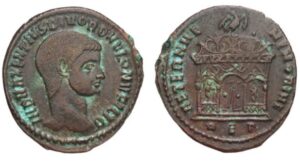 That coin was minted in 310 and 311 AD and, according to the numismatologists (of the Münzkabinett, Staatliche Museen zu Berlin) shows marcus Valerius Romulus, the son of Maxentius, on the head side. He died in 309 and father Maxentius had a large mausoleum built for him, in which his body was added. On the reverse side of the coin is a tomb temple with Somnus and his brother Thanatos in the niches on the left and right named Mors by the Romans.
That coin was minted in 310 and 311 AD and, according to the numismatologists (of the Münzkabinett, Staatliche Museen zu Berlin) shows marcus Valerius Romulus, the son of Maxentius, on the head side. He died in 309 and father Maxentius had a large mausoleum built for him, in which his body was added. On the reverse side of the coin is a tomb temple with Somnus and his brother Thanatos in the niches on the left and right named Mors by the Romans.
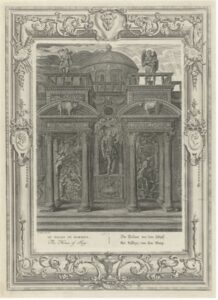 On the print ‘The Palace of Sleep’ by Hypno (1773) we see a similar temple. On top of the building are the goddesses Diana and Night. Night has in her arms her children Sleep (Hypnos) and Death (Thanatos). In the middle of the niche stands Sleep with poppies in his hand. In the house it is teeming with the Oneiroi (Dreams). The pillars form a gate on the left side and on the right side through which the dreams come out. Above the left gate is an elephant. His ivory tusks refer to the ivory gate from which deceitful dreams come. Devilish guises and trampling people tumble out. The cow on the right personifies the polished horns gate through which the true dreams fly out. Stars, a crescent moon and wonderful people with Indian headdress and turban stand for exotic dreams.
On the print ‘The Palace of Sleep’ by Hypno (1773) we see a similar temple. On top of the building are the goddesses Diana and Night. Night has in her arms her children Sleep (Hypnos) and Death (Thanatos). In the middle of the niche stands Sleep with poppies in his hand. In the house it is teeming with the Oneiroi (Dreams). The pillars form a gate on the left side and on the right side through which the dreams come out. Above the left gate is an elephant. His ivory tusks refer to the ivory gate from which deceitful dreams come. Devilish guises and trampling people tumble out. The cow on the right personifies the polished horns gate through which the true dreams fly out. Stars, a crescent moon and wonderful people with Indian headdress and turban stand for exotic dreams.

It wasn’t entirely new to put Somnus on a coin. Between 193 and 217 (AD) Julia Domna (170 – 217) was Roman Empress. During her reign she had a coin minted with herself on one side and on the reverse a winged Somnus lying on a lion’s coat and a torch in his hand. Domna was one of the most powerful persons in the Severian house and probably one of the most powerful empresses known to the Roman Empire. She was celebrated as the woman who once again gave philosophy a leading position in the Roman Empire and was praised for her political acumen. Her two sons could drink each other’s blood. Both ended by killer’s hand, and that led Julia Domna to suicide by hunger strike.
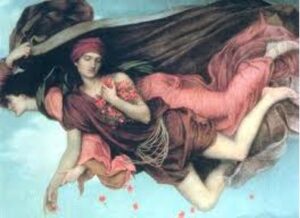
The image on the coin is reminiscent of the prints that Mother Nix (Night) represents. As she flies over the earth with Hypnos, she brings darkness with her black cape and Hypnos scatters the soporific poppies.
If Hypnosis is depicted leaning against a lion or as on julia domna’s coin lies on a leuwen skin then it is thus expressed that sleep controls everything. Painter and Hypnos adept Fernand Khnopff, painted Hypnos in combination with a Sphinx with panther skin.
Des caresses, 1896, Museum of Fine Arts, Brussels. / Affection of the Belgian painter Fernand Khnopff

Around 1966, designer Rudi Gernreich devised a ‘second skin’ with tiger print because he felt that sexually liberated women should look like jungle beasts Fashion designer Azzedine Alaïa known for his ‘form fitting’ couture; clothing as second skin dressed in 1991 are models in leopard prints. For example, a woman in a fur coat looks like a big cat: cuddly, but beware of the claws. Maybe empress Julia Domnus wanted to be seen that way.
The Greco-Roman author Pausanias (150 AD) mentioned in his travel guide ‘Description of Greece’ that he saw a temple for Asclepius in the town of Sicyon. There are images of Oneiros and Hypnos lulling a lion to sleep. Pausanias uses the name Epidotes for Hypnos, which means “free giver”, a nickname by which other gods such as Zeus, Mantineia and Sparta are also referred to.
Horizontal double portrait
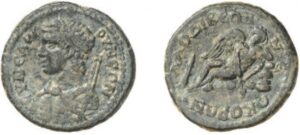
The twins Hypnosis and Thanatos personify sleep and death. Their attributes are the poppy as a soporific plant and the extinguished torch as the extinguished life. Sleep is often called the small death. Sometimes the brothers are portrayed as one person. This is also the case on this coin from 218-222 Na C. On the head side a young Macedonian senator with diadem and on the other side a winged Somnus / Thanatos with a poppy wreath around the head and lying on a rock. Against his foot stands an inverted extinguished torch.
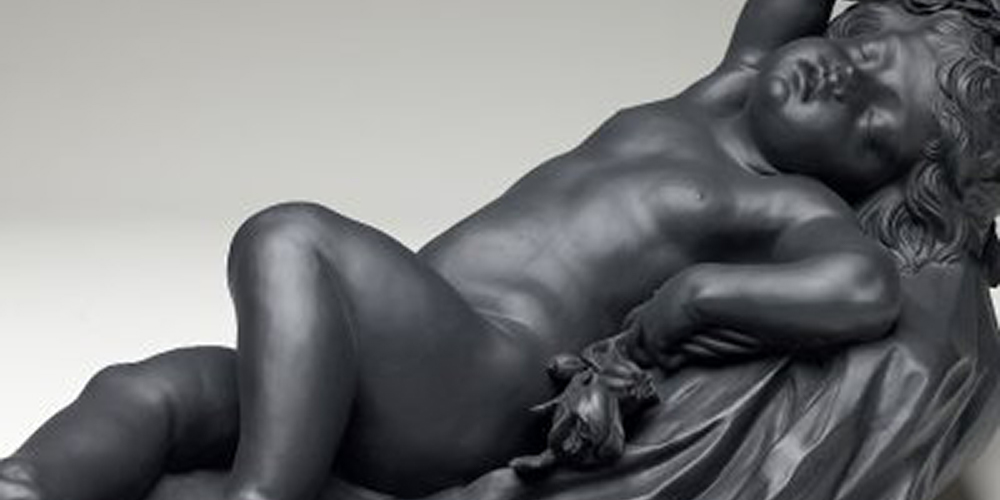 Sometimes Somnus is portrayed as a lying sleeping child like this black Somnus.
Sometimes Somnus is portrayed as a lying sleeping child like this black Somnus.
In 1770 Josiah Wedgwood Bentley and his partner Thomas Bentley paid five pounds sterling to have a plaster mold made. Their example was the black marble Somnus that Alessandro Algardi made in 1630 and now stands in Galleria Borghese in Rome. With the plaster mold they made Somnus figurines of black basalt and although Wedgwood mentions his image in his sales catalogue Morpheus it is now recognized as Somnus. Here, too, the sleeping god lies on a rocky bottom. With his right arm over his head and in his left hand a bunch of poppies. Although they were once made in series, only two copies have been known worldwide.
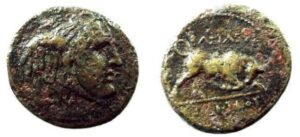
Seleucus I (358 – September 281 BC), nicknamed Nicator (i.e. “victor”) accompanied general Alexander the Great on his journey to Asia. Then, during his reign, he put a coin into circulation with a bull on one side and the winged head of Hypnos on one side.
During one of his military adventures, Seleucus tried to take advantage of the confusion among his opponents by spreading fabricated stories in the provinces and among their soldiers. According to one, in a dream, he had seen Alexander standing next to him suggesting that he had his support.
After the Greeks conquered Egypt under the leadership of Alexander, they looked for ways to unite both peoples. Therefore, they united several important Greek gods, such as Zeus and Hades with the Egyptian Osiris and bull Apis. The ‘new’ god Serapis, could worship both Greeks and Egyptians,
Ancient sources mention that Seleucus visited the temple of the god Serapis just before Alexander’s death. This contraction between Osiris and the bull god Apis was attributed to healing talents by Asclepius. Seleucus is said to have slept in the temple in the hope that Alexander’s health would improve. However, this story is doubted because the Greek-Egyptian Serapis had not yet been invented at that time. Perhaps he visited a temple of Asclepius where there was usually a place for Hypnos.
The bull god Apis was a fertility symbol with which kings of the Old Empire liked to move. Would Seleucus portray himself on the coin and underline his dream support of Alexander the Great with the image of the god of sleep and dreams? To highlight that vision, a coin that went hand-to-hand was an ideal propaganda tool.
During the reign of the Ptolemaic, the worship of the Apisstier became a real cult. The choice by priests of a young black bull with a white square on his forehead was accompanied by a great feast. The bull’s death followed days of national mourning. Because the bull connected with Osiris after his death, he was also a god of death.
The combination god Serapis was not yet born. Did Seleucus try first with the Greek Hypnos and the Egyptian Apis? The combination of sleep and death already existed. Life and death as two sides of a coin?
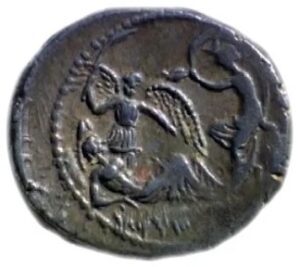 In 44 BC, the Romanes paid for their messages with a denarius bearing the funeral of Julius Caesar. She shows his wax effigy (simulacrum) as the shepherd/king Endymion, resurrected from sleep/death, as moon goddess Selene (Luna) gets off her wagon to visit him. She is best known for her love for the shepherd Endymion, who eventually became a god.
In 44 BC, the Romanes paid for their messages with a denarius bearing the funeral of Julius Caesar. She shows his wax effigy (simulacrum) as the shepherd/king Endymion, resurrected from sleep/death, as moon goddess Selene (Luna) gets off her wagon to visit him. She is best known for her love for the shepherd Endymion, who eventually became a god.
The winged figure with the torch of immortality is possibly Hypnos (Somnus)
Money in the temple, right?
Hypnotherapist indebted to Hypnos
In the vast kingdom of the Gods of the Romans and Greeks, Hypnos was a small but feisty little god who was apparently important enough to raise awareness of each coin from time to time.
Most other gods have no more than one expression. We can run into a box of Pandorra, have an Archileshiel, do Sisifuswork by fattening an Augiastal and end up being dead anyway.
But the star of Hypnos is steadily rising. Not only has he had a growing following worldwide in the person of thousands of hypnotherapists since 1843, his currency is also growing in value.
With a drachma on which a bull and Somnus stand, a Roman could buy a loaf of bread 2,300 years ago after his visit to the Somnus Temple. Now he pays for an hour of hypnotherapy. (€85.00)
With an assarion you could buy a bag full of groceries around 200 AD in the city of Nikopolis ad Istrum where Julia Domna was in charge. If the modern hypnotherapist accepts this currency in his temple, it is good for a hypnotic gastric band. (€450.00)
©2020, Johan Eland

